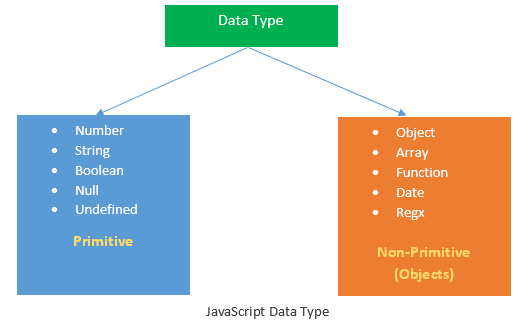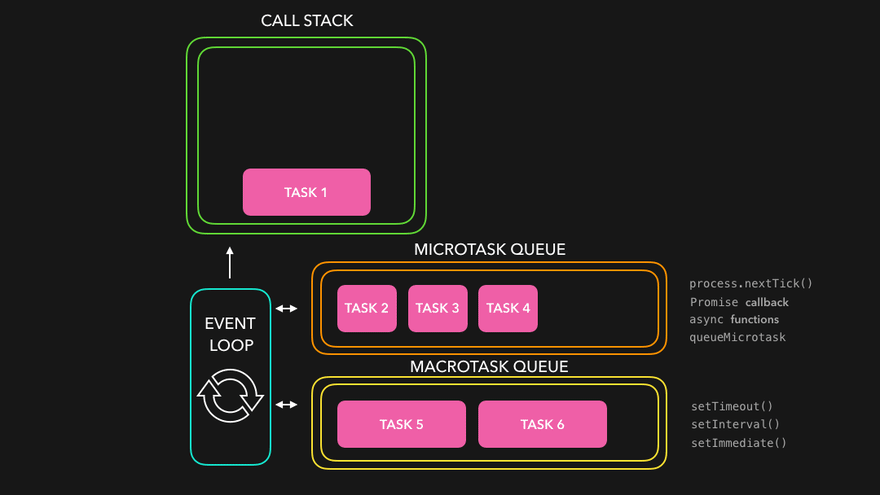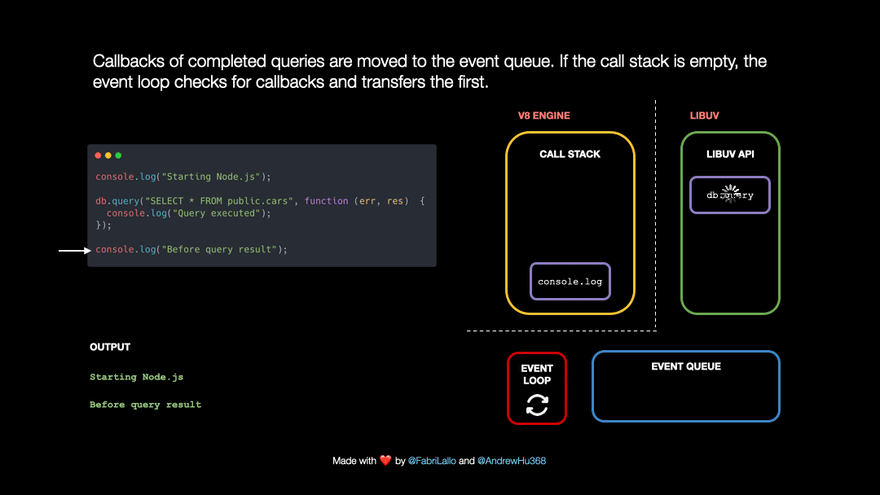- Variables are named values and can store any type of JavaScript value.
var x = 100;
let y=100;
const z= 200;
- Scope refers to the availability and accessibility of variables and functions in certain parts of the code. JavaScript has 3 types of scope:
- i)
Block scope - ii)
Function scope or local scope - iii)
Global scope
- Before ES6 (2015), JavaScript had only Global Scope and Function Scope.
- ES6 introduced two important new JavaScript keywords: let and const.
- These two keywords provide Block Scope in JavaScript.
- Variables declared inside a { } block cannot be accessed from outside the block
{
let x = 2;
}
// x can NOT be used here
{
var x = 2;
}
// x CAN be used here
- Variables declared with the
varkeyword can NOT have block scope. - var Variables declared inside a { } block can be accessed from outside the block.
- Variables declared within a JavaScript function, become LOCAL to the function.
- Local variables have Function Scope.
- it can only be accessed within a function
// code here can NOT use carName
function myFunction() {
let carName = "Volvo";
// code here CAN use carName
}
// carName can't be accessed here (outside function)
- Variables declared Globally (outside any function) have Global Scope.
- Global variables can be accessed from anywhere in a JavaScript program.
let a = "hello"; // global declared
function greet() {
a = 3;
}
// before the function call
console.log(a);
//after the function call
greet();
console.log(a); // 3
- Hoisting in JavaScript is a behavior in which a function or a variable can be used before. declaration
a = 5; // assign value
console.log(a); // use
var a; // declare
| var | let | const |
|---|---|---|
The scope of a var variable is functional scope.. |
The scope of a let variable is block scope. |
The scope of a const variable is block scope. |
It can be updated and re-declared into the scope.. |
It can be updated but cannot be re-declared into the scope.. | It cannot be updated or re-declared into the scope. |
| It can be declared without initialization. | It can be declared without initialization. | It cannot be declared without initialization.. |
| It can be accessed without initialization as its default value is “undefined”. | It cannot be accessed without initialization otherwise it will give ‘referenceError’. | It cannot be accessed without initialization, as it cannot be declared without initialization.. |
| hoisting done, with initializing as ‘default’ value | Hoisting is done, but not initialized (this is the reason for the error when we access the let variable before declaration/initialization | Hoisting is done, but not initialized (this is the reason for the error when we access the const variable before declaration/initialization |
- a closure gives you access to an
outer function's scope from an inner function
function init() {
var name = "Mozilla"; // name is a local variable created by init
function displayName() {
// displayName() is the inner function, that forms the closure
console.log(name); // use variable declared in the parent function
}
displayName();
}
init();
// Numbers:
let length = 16;
let weight = 7.5;
//undefined
let x; // Now x is undefined
//null
let x=null; // Now x is null
// Strings:
let color = "Yellow";
let lastName = "Johnson";
// Booleans
let x = true;
let y = false;
// Object:
const person = {firstName:"John", lastName:"Doe"};
// Array object:
const cars = ["Saab", "Volvo", "BMW"];
// Date object:
const date = new Date("2022-03-25");
var apple = "apple";
console.log(typeof apple); // string
var number = 2052021;
console.log(typeof number); // number
typeof "John" // Returns "string"
typeof 3.14 // Returns "number"
typeof NaN // Returns "number"
typeof false // Returns "boolean"
typeof [1,2,3,4] // Returns "object"
typeof {name:'John', age:34} // Returns "object"
typeof new Date() // Returns "object"
typeof function () {} // Returns "function"
typeof myCar // Returns "undefined" *
typeof null // Returns "object"
- In programming, type conversion is the process of converting data of one type to another. For example: converting String data to Number.
- There are two types of type conversion in JavaScript.
Implicit Conversion- automatic type conversionExplicit Conversion- manual type conversion
More Details: https://www.programiz.com/javascript/type-conversion#google_vignette
- JavaScript object is a non-primitive data-type that allows you to store multiple collections of data.
how to create object:
//1
const person = {
firstName: 'testFirstName',
lastName: 'testLastName'
};
//2
const person = new Object();
person.firstName = 'testFirstName';
person.lastName = 'testLastName';
Accessing Object Properties:
- You can access the value of a property by using its key.
1. Using dot Notation
// syntax objectName.key
const person = {
name: 'John',
age: 20,
};
// accessing property
console.log(person.name); // John
2. Using bracket Notation
// syntax objectName["propertyName"]
const person = {
name: 'John',
age: 20,
};
// accessing property
console.log(person["name"]); // John
how to create and access on Nested Objects
// nested object
const student = {
name: 'John',
age: 20,
marks: {
science: 70,
math: 75
}
}
// accessing property of student object
console.log(student.marks); // {science: 70, math: 75}
// accessing property of marks object
console.log(student.marks.science); // 70
Object.Create More Details: https://github.com/vignesh222s/js-tutorial/blob/main/image/d8db05d2-3938-43ec-8233-acb5dc3aef2f.jpg?raw=true
- JavaScript is a single-threaded programming language. This means that JavaScript can do only one thing at a single point in time.
- The JavaScript engine executes a script from the top of the file and works its way down. It creates the execution contexts, pushes, and pops functions onto and off the call stack in the execution phase.
example:
function greet() {
console.log('Hello world');
}
function abc() {
setTimeout(()=>{
console.log("later")
},4000)
}
setTimeout(greet, 3000);
console.log('This message is shown first');
abc();
- synchronous means to be in a sequence, i.e.
every statement of the code gets executed one by one. So, basically a statement has to wait for the earlier statement to get executed.
example
console.log("first");
console.log("second");
console.log("third");
- Functions running in parallel with other functions are called asynchronous.A good example is JavaScript setTimeout()
example
console.log("first");
setTimeout(()=>{
console.log("I will finish later!")
},2000)
console.log("third");
- The setTimeout() method executes a block of code after the specified time. The method executes the code only once.
example
function greet() {
console.log('Hello world');
}
function abc() {
setTimeout(()=>{
console.log("later")
},4000)
}
setTimeout(greet, 3000);
console.log('This message is shown first');
abc();
- The setInterval() method calls a function at specified intervals (in milliseconds).
- The setInterval() method continues calling the function until
clearInterval()is called, or the window is closed.
example
function myTimer() {
const d = new Date();
console.log( d.toLocaleTimeString())
}
setInterval(myTimer, 1000);
- A callback is a function passed as an argument to another function. This technique allows a function to call another function. A callback function can run after another function has finished.
// a few friends have planned for a trip.money ,car and route map is needed for the trip.
// money can be arranged after 5 sec. car can be arranged in 3 sec .route map can be arranged in
//1 sec .only after we get all this the tour can be successful .
// step 1
const money=(amt,car)=>{
setTimeout(()=>{
console.log(" "+amt+" arranged money")
let step1="stpe1 completed"
car(step1,RouteMap)
},6000)
}
// step 2
const car=(step1,RouteMap)=>{
setTimeout(()=>{
console.log(step1)
console.log("received money arranged car with the money")
let step2="stpe2 completed"
RouteMap(step2,status)
},4000)
}
// step 3
const RouteMap=(step2,status)=>{
setTimeout(()=>{
console.log(step2)
console.log("got route map")
let step3="stpe3 completed"
status(step3)
},3000)
}
const status=(step3)=>{
setTimeout(()=>{
console.log(step3)
console.log("trip,completed successfully!!")
},3000)
}
money(10000,car)
example 2:
const money =(amt,callback)=>{
setTimeout(()=>{
console.log(" "+amt+" arranged money")
let step1="stpe1 complete";
callback(step1);
},6000)
}
const car=(res1,callback)=>{
setTimeout(()=>{
console.log(res1)
console.log("received money arranged car with the money")
let step2="stpe2 complete";
callback(step2)
},5000)
}
const routeMap =(res2,callback)=>{
setTimeout(()=>{
console.log(res2)
console.log("got route map")
let step3="stpe3 complete"
callback(step3)
},3000)
}
const status=(res3)=>{
setTimeout(()=>{
console.log(res3)
console.log("trip,completed successfully!!")
},2000)
}
money(10000, function(res1){
car(res1,function(res2){
routeMap(res2,function(res3){
status(res3)
})
})
})
async/await:
- We use the async keyword with a function to represent that the function is an asynchronous function. The async function returns a promise.
- The await keyword is used inside the async function to wait for the asynchronous operation.
- async makes a function return a Promise
- await makes a function wait for a Promise
const money = () => {
return new Promise((resolve) => {
setTimeout(() => {
console.log("Arranged money");
let step1="step1 complete"
resolve(step1);
}, 6000);
});
};
const car = (msg) => {
return new Promise((resolve) => {
setTimeout(() => {
console.log(msg)
console.log("Received money, arranged car with the money");
resolve();
}, 5000);
});
};
const routeMap = () => {
return new Promise((resolve) => {
setTimeout(() => {
console.log("Got route map");
resolve();
}, 4000);
});
};
const status = () => {
return new Promise((resolve) => {
setTimeout(() => {
console.log("Trip completed successfully!!");
resolve();
}, 3000);
});
};
const res = async () => {
const result=await money();
await car(result);
await routeMap();
await status();
};
res();
Promises:
- A Promise is a JavaScript object that links producing code and consuming code.
- Producing code is code that can take some time.
- Consuming code is code that must wait for the result.
why used:
- In JavaScript, a promise is a good way to handle asynchronous operations. It is used to find out if the asynchronous operation is successfully completed or not.
- A promise may have one of three states.
- Pending
- Fulfilled
- Rejected
- A promise starts in a pending state. That means the process is not complete. If the operation is successful, the process ends in a fulfilled state. And, if an error occurs, the process ends in a rejected state.
Create a Promise
let promise = new Promise(function(resolve, reject){
//do something
});
More Details: https://www.programiz.com/javascript/promise
Promise.then():
- The then() method returns a Promise. It takes up to two arguments: callback functions for the success and failure cases of the Promise.
const promise1 = new Promise((resolve, reject) => {
resolve('Success!');
});
promise1.then((value) => {
console.log(value);
// expected output: "Success!"
}, (error) => {
console.log( error);
});
Promise.catch()::
Promises Vs Callback:
Promise.finally():
- The finally() method returns a Promise. When the promise is settled, the specified callback function is executed. This provides a way for code to be run irrespective of promise settlement. A finally callback will not receive any argument, since there is no way of determining if the promise was fulfilled or rejected.
const promise1 = Promise.reject("Rejecting Promise");
promise1
.then(value => {
console.log(value)
})
.catch(err => {
console.log(err)
})
.finally(() => {
console.log("completed promise")
});
> "Rejecting Promise"
> "completed promise"
examples
const money = () => {
return new Promise((resolve) => {
setTimeout(() => {
console.log("Arranged money");
let step1 = "step1 complete";
resolve(step1);
}, 6000);
});
};
const car = (msg) => {
return new Promise((resolve) => {
setTimeout(() => {
console.log(msg);
console.log("Received money, arranged car with the money");
resolve();
}, 5000);
});
};
const routeMap = () => {
return new Promise((resolve) => {
setTimeout(() => {
console.log("Got route map");
resolve();
}, 4000);
});
};
const status = () => {
return new Promise((resolve) => {
setTimeout(() => {
console.log("Trip completed successfully!!");
resolve();
}, 3000);
});
};
money()
.then((result) => {
return car(result);
})
.then(() => {
return routeMap();
})
.then(() => {
return status();
})
.catch((error) => {
console.error("An error occurred:", error);
});
Promises Methods:
1.Promise.all():
waits for all promises to be resolved or any one to be rejected.- Promise.all() method takes an array of promises and returns a single promise, which is either resolved or rejected based on any iterable promise. It resolves if all the promises inside the array resolve and reject if any of the promises reject.
example
const promise1 = Promise.resolve("hello world");
const promise2 = "Promise 2";
const promise3 = new Promise((resolve, reject) => {
setTimeout(resolve, 100, 'foo');
});
Promise.all([promise1, promise2, promise3]).then((values) => {
console.log(values);
});
// expected output: Array ["hello world", "Promise 2", "foo"]
example2
const pro1 = new Promise((resolve, reject) => {
setTimeout(() => resolve("one"), 1000);
});
const pro2 = new Promise((resolve, reject) => {
setTimeout(() => resolve("two"), 2000);
});
const pro3 = new Promise((resolve, reject) => {
setTimeout(() => reject("rejected"), 3000);
});
Promise.all([pro1, pro2, pro3])
.then((values) => {
console.log(values);
})
.catch((error) => {
console.log(error);
});
//expected output: rejected
2.Promise.any():
Returns the promise value as soon as any one of the promises is fulfilled
example
const SlowlyDone = new Promise((resolve, reject) => {
setTimeout(resolve, 500, "Done slowly");
}); //resolves after 500ms
const QuicklyDone = new Promise((resolve, reject) => {
setTimeout(resolve, 100, "Done quickly");
}); //resolves after 100ms
const Rejection = new Promise((resolve, reject) => {
setTimeout(reject, 100, "Rejected"); //always rejected
});
Promise.any([SlowlyDone, QuicklyDone, Rejection])
.then((value) => {
console.log(value);
// QuicklyDone fulfils first
})
.catch((err) => {
console.log(err);
});
3.Promise.race():
Wait until any of the promises is resolved or rejected
example
const pro1 = new Promise((resolve, reject) => {
setTimeout(() => resolve("one"), 200);
});
const pro2 = new Promise((resolve, reject) => {
setTimeout(() => resolve("two"), 100);
});
Promise.race([pro1, pro2])
.then((response) => {
console.log(response); //output: two
})
.catch((err) => {
console.log(err);
});
const pro3 = new Promise((resolve, reject) => {
setTimeout(() => reject("rejected"), 300);
});
const pro4 = new Promise((resolve, reject) => {
setTimeout(() => resolve("four"), 400);
});
Promise.race([pro3, pro4])
.then((response) => {
console.log(response);
})
.catch((err) => {
console.log(err);
}); //output: rejected
4.Promise.allSettled():
Waits until all promises are either resolved or rejected
example:
let first_promise = Promise.resolve(200);
let second_promise = Promise.reject("Rejected Promise");
let third_promise = new Promise((resolve, reject) => {
setTimeout(() => resolve(500), 100)
});
let result =
Promise.allSettled([first_promise, second_promise, third_promise]);
result.then((value) => console.log(value));






















